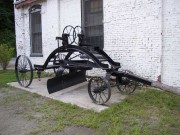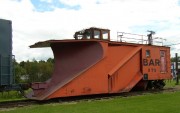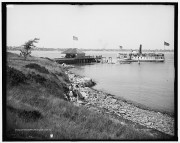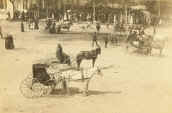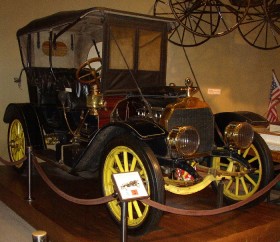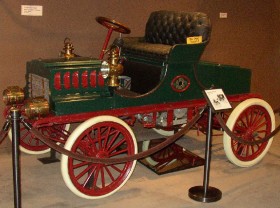For the earliest residents, Native Americans, dugout canoes were the vehicles of choice along the coast. Full use of rivers, lakes and streams awaited the invention of the lighter birch bark canoe, which could be carried from one water body to another, creating important links inland and to the north.
After the Europeans arrived, rivers were tamed first by sailing vessels, then by steam boats. Casco Bay was well served by steamboats, as was the nearby New Meadows River serving Brunswick, Bath, West Bath and Harpswell.
The service on the river for passengers and light freight was provided by the New Meadows Steamboat company, which started at about the turn of the [twentieth] century with the New Meadows, primarily for summer vacationers, many from Bath, along the river all the way down to Small Point. The company’s base of operations was New Meadows Landing where the Steamer Sebascodegan, Orr’s Island Line from the
Bath-Brunswick Highway – old Route 1 – crossed the river. Now long gone and nearly forgotten are the days when a cottager could give an order for groceries or other items to the master of the morning boat, have it telephoned to Bath by the agent at the landing, have the required items sent out by street car to be transferred to the boat, and dropped off on the day’s last run. [Baker, p. 751]
The steamboats later gave way to railroads, which gave way to highways. Early roads and highways were, of course, populated by horse drawn vehicles until automobiles began crowding them out in the 20th century. Transportation has long been critical to the Maine economy. Prior to the auto, towns relied on hay for fuel, carriage factories, blacksmiths, harness works and stage lines for employment.
Early automobiles were manufactured in Maine, as evidenced by the two vehicles pictured below and on exhibit at the Maine State Museum in Augusta. At left is the Burrowes “Model E” Tourabout made by E. T. Burrowes Company in Portland in 1908. At right is the Rawnsley “Runabout” made by Hollon Rawnsley in Springvale 1904-1905.
Here are some other resources relating to transportation in Maine:
- Rivers, the original inland routes
- Canals supplemented navigation on some rivers and streams
- Bridges eventually replaced the many ferries crossing the rivers
- Clipper ships and other sailing vessels
- The Airline, an early East-West highway
- Highway mileage between selected points in Maine.
- A brief history of railroads.
- Airports in Maine
- Employment in the transportation industry
Additional resources
Baker, William Avery. A Maritime History of Bath, Maine and the Kennebec River Region. Bath, Me. Marine Research Society of Bath. 1973.
Baxter, Percival P. Maine Roads, 1923: address of Percival P. Baxter, Governor of Maine at annual banquet of Maine Automobile Association, Portland, October 2, 1923. [University of Maine, Raymond H. Fogler Library, Special Collections; Bangor Public Library; Maine State Library]
Biennial Transportation Improvement Program. (various years) Augusta, Me. Maine Department of Transportation.
Kjenstad, Lowell G. Cole Land Transportation Museum: The Collection. Bangor, Me. Cole Land Transportation Museum. 1998.
Leavitt, Harold Walter. Some Interesting Phases of the Development of Transportation in Maine. Orono, Me. University of Maine Press. 1940. [University of Maine, Raymond H. Fogler Library, Special Collections; Bangor Public Library; Maine State Library]
Prints & Photographs Online Catalog. Library of Congress Prints and Photographs Division Washington, D.C. 20540.
Steamboat Sebascodegan: LC-D418-9319 (b&w glass neg.) At http://www.loc.gov/pictures/resource/det.4a27250/.
Steamboat at Cushing Landing: 2LC-D4-71510 (b&w glass neg.) At http://www.loc.gov/pictures/resource/det.4a23473/.
Thorndike, Virginia L. How We Got There From Here: remembering the days of steamers, trolleys & model Ts in Maine. Camden, Me. Down East Books. c1997.
Wardwell, W. Emory. From Horse Trails to Steel Rails. published under the auspices of the Worcester Historical Society, Worcester, Mass. Rockport, Me. Falmouth Publishing House. c1955.


